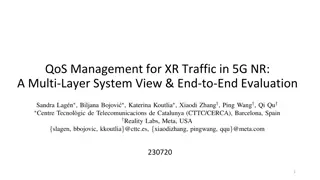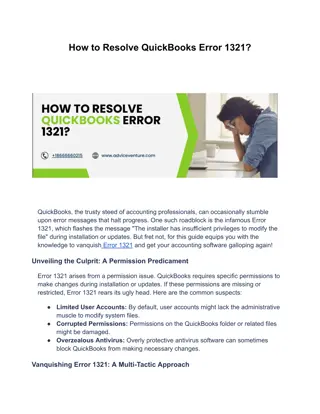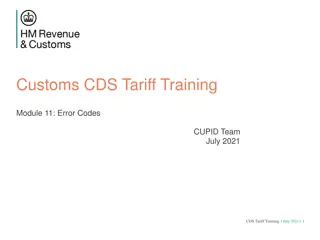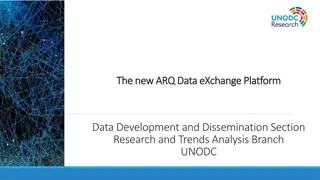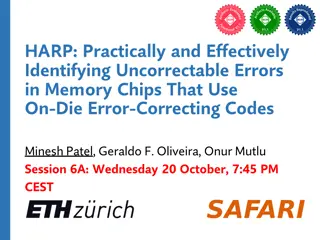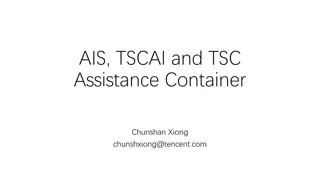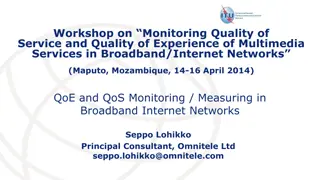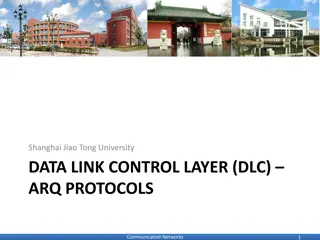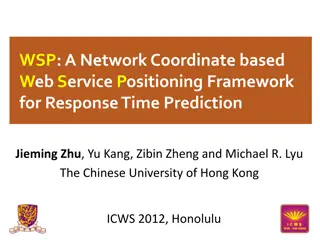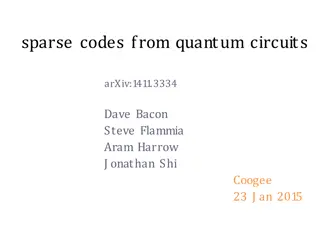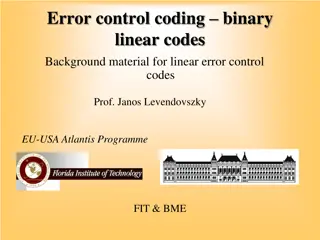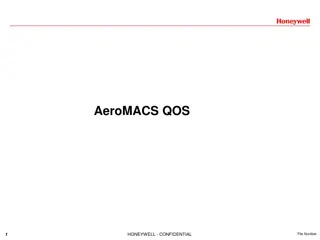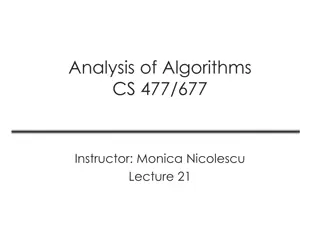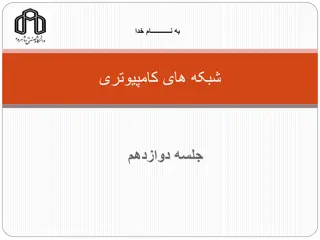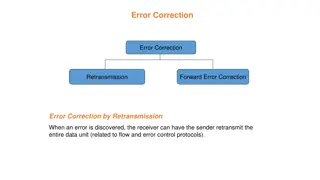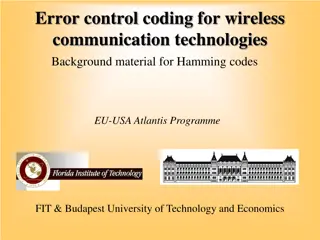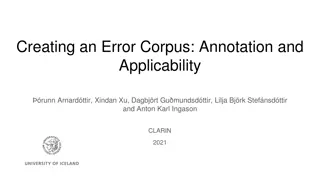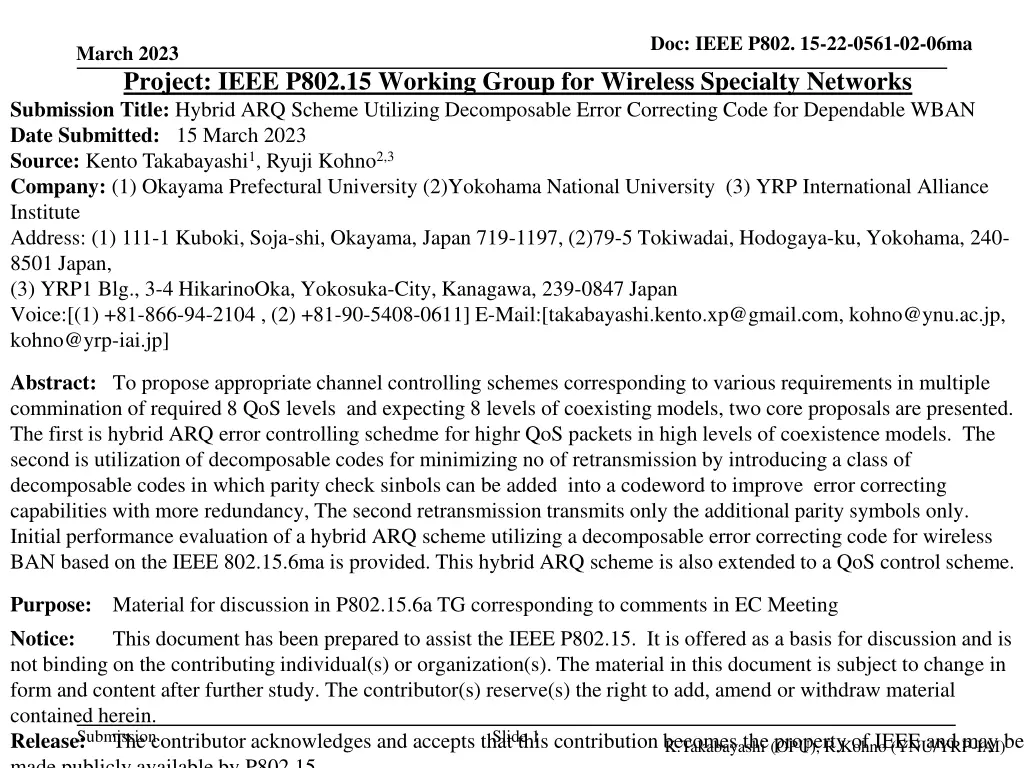
Hybrid ARQ Scheme Utilizing Decomposable Error Correcting Code
"Explore a hybrid ARQ scheme utilizing decomposable error correcting code for dependable Wireless Body Area Networks. The proposal includes channel controlling schemes for various QoS levels and coexistence models, enhancing error correcting capabilities while minimizing retransmission. Initial performance evaluation and extension to QoS control scheme also discussed."
Download Presentation

Please find below an Image/Link to download the presentation.
The content on the website is provided AS IS for your information and personal use only. It may not be sold, licensed, or shared on other websites without obtaining consent from the author. If you encounter any issues during the download, it is possible that the publisher has removed the file from their server.
You are allowed to download the files provided on this website for personal or commercial use, subject to the condition that they are used lawfully. All files are the property of their respective owners.
The content on the website is provided AS IS for your information and personal use only. It may not be sold, licensed, or shared on other websites without obtaining consent from the author.
E N D
Presentation Transcript
Doc: IEEE P802. 15-22-0561-02-06ma March 2023 Project: IEEE P802.15 Working Group for Wireless Specialty Networks Submission Title: Hybrid ARQ Scheme Utilizing Decomposable Error Correcting Code for Dependable WBAN Date Submitted: 15 March 2023 Source: Kento Takabayashi1, Ryuji Kohno2,3 Company: (1) Okayama Prefectural University (2)Yokohama National University (3) YRP International Alliance Institute Address: (1) 111-1 Kuboki, Soja-shi, Okayama, Japan 719-1197, (2)79-5 Tokiwadai, Hodogaya-ku, Yokohama, 240- 8501 Japan, (3) YRP1 Blg., 3-4 HikarinoOka, Yokosuka-City, Kanagawa, 239-0847 Japan Voice:[(1) +81-866-94-2104 , (2) +81-90-5408-0611] E-Mail:[takabayashi.kento.xp@gmail.com, kohno@ynu.ac.jp, kohno@yrp-iai.jp] Abstract: To propose appropriate channel controlling schemes corresponding to various requirements in multiple commination of required 8 QoS levels and expecting 8 levels of coexisting models, two core proposals are presented. The first is hybrid ARQ error controlling schedme for highr QoS packets in high levels of coexistence models. The second is utilization of decomposable codes for minimizing no of retransmission by introducing a class of decomposable codes in which parity check sinbols can be added into a codeword to improve error correcting capabilities with more redundancy, The second retransmission transmits only the additional parity symbols only. Initial performance evaluation of a hybrid ARQ scheme utilizing a decomposable error correcting code for wireless BAN based on the IEEE 802.15.6ma is provided. This hybrid ARQ scheme is also extended to a QoS control scheme. Purpose: Notice: not binding on the contributing individual(s) or organization(s). The material in this document is subject to change in form and content after further study. The contributor(s) reserve(s) the right to add, amend or withdraw material contained herein. Release: Material for discussion in P802.15.6a TG corresponding to comments in EC Meeting This document has been prepared to assist the IEEE P802.15. It is offered as a basis for discussion and is Submission The contributor acknowledges and accepts that this contribution becomes the property of IEEE and may be made publicly available by P802.15 Slide 1 K.Takabayashi (OPU), R.Kohno (YNU/YRP-IAI)
Doc: IEEE P802. 15-22-0561-01-06ma March 2023 QoS-aware Hybrid ARQ Scheme Utilizing Decomposable Error Correcting Codes for Wireless Body Area Networks March 15, 2023 Atlanta, Georgia, USA Kento Takabayashi(1), Ryuji Kohno(2, 3) (1)Okayama Prefectural University (2)Yokohama National University, (3)YRP-International Alliance Institute Slide 2 Submission K.Takabayashi (OPU), R.Kohno (YNU/YRP-IAI)
Doc: IEEE P802. 15-22-0561-02-06ma March 2023 Agenda 1. Requirement for Channel Coding for TG6ma 2. Review of error control in IEEE802.15.6 3. Hybrid ARQ Proposal for High QoS Use cases for WBAN 4. Preliminary Performance Analysis 5. Concluding Remark Submission Slide 3 K.Takabayashi (OPU), R.Kohno (YNU/YRP-IAI)
Doc: IEEE P802. 15-22-0561-02-06ma March 2023 1. Requirement for Channel Coding for TG6ma 1.1 Eight QoS Levels of Packets. TG15.6ma revision supports QoS. Currently, the 15.6 2012 Std defines QoS in terms of traffic type indicated in the below table and used as reference: User priority QoS 0 1 2 3 4 5 6 7 Traffic type Background Best effort Excellent effort Video Voice Medical or network control High priority medical or network control Emergency or implant Various criteria to determine QoS level of packets mainly required max packet error rate, throughput(permissible packet loss), permissible delay or backoff time, according to TRD. Submission Slide 4 K.Takabayashi (OPU), R.Kohno (YNU/YRP-IAI)
Doc: IEEE P802. 15-22-0561-02-06ma March 2023 1. Requirement for Channel Coding for TG6ma 1.2 Eight Levels of Coexistence TG15.6ma revision supports system performance in eight levels of coexistence models , which 6ma BAN could co-exit with the same and other radios. Appropriate channel codes should be designed into individual coexistence models to satisfy required performance in individual coexistence environments Submission Slide 5 K.Takabayashi (OPU), R.Kohno (YNU/YRP-IAI)
Doc: IEEE P802. 15-22-0561-02-06ma March 2023 1. Requirement for Channel Coding for TG6ma 1.3 8x8(64) Channel Coding Schemes for Combination of 8 QoS levels of Packets and 8 Coexistence Levels The coexistence parameters are classified as MAC: 1) CFP, 2) CAP. PHY, FEC: 1) (BCC, LDPC), 2) External FEC (Super-orthogonal CC), 3) Interference Mitigation techniques. MAC & PHY: HARQ (composable CC). A combination of such techniques and QoS gives the different modes of transmission depending on the required QoS and the interference environment of operation: High coexistence level support means high intra-interference or inter-interference or both. Hence, operation in the CFP cannot be guarantee. The CFP would be preferable for transmission of high QoS traffic in low or non-interference environment. QoS/Cox 0 1 2 3 4 5 6 7 BCC BCC BCC BCC BCC BCC+E BCC+E BCC+E BCC+E BCC+E BCC+E BCC+E BCC+E BCC+E BCC+E BCC+E BCC+E BCC+E BCC+E BCC+E HARQ HARQ HARQ HARQ HARQ HARQ HARQ HARQ HARQ HARQ 0 1 2 3 4 BCC BCC+E BCC+E BCC+E HARQ/IM HARQ/IM 5 CFP/HAR Q CFP/HAR Q CFP/HAR Q CFP/HAR Q CFP/HAR Q CFP/HAR Q CFP/HAR Q CFP/HAR Q CFP/HAR Q CFP/HAR Q CFP/HAR Q CFP/HAR Q HARQ/IM HARQ/IM 6 HARQ/IM HARQ/IM 7 Submission Slide 6 K.Takabayashi (OPU), R.Kohno (YNU/YRP-IAI)
Doc: IEEE P802. 15-22-0561-02-06ma March 2023 2. Error control in IEEE802.15.6 IEEE802.15.6 shall use a (63, 51) BCH code as an error correcting code in narrowband, UWB and HBC PHY Only user priority 6 data in UWB-PHY may use a hybrid ARQ with a (126, 63) shortened BCH code WBAN may deal with 8 levels of user priority data Those data have a wide range of quality of service (QoS) The error controlling of the current IEEE Std. 802.15.6 cannot cope with it because of lack of flexibility Submission Slide 7 K.Takabayashi (OPU), R.Kohno (YNU/YRP-IAI)
Doc: IEEE P802. 15-22-0561-02-06ma March 2023 3. Proposed Hybrid ARQ Scheme for WBAN Proposed QoS control scheme using decomposable error correcting codes and Weldon s ARQ protocol It is based on punctured convolutional codes (constraint length ? = 3 and coding rates ??of 8/9 to 1/16) The ??= 8/9 punctured code patterns (codeword 1 and codeword 1') are generated as shown in the next figure At the first transmission, codeword 1 is sent To increment the coding rate of the punctured code, elements of codeword 1' are sent after the first transmission After sending all elements to reconstruct the original convolutional code, codewords 1 and 1' are transmitted alternately A receiver reconstructs and decodes low-rate decomposable codes by changing the number of data copies in Weldon's ARQ protocol Submission Slide 8 K.Takabayashi (OPU), R.Kohno (YNU/YRP-IAI)
Doc: IEEE P802. 15-22-0561-02-06ma March 2023 3. Proposed hybrid ARQ scheme for WBAN 1. Firstly, the information bit sequence ? is encoded via the punctured convolutional code, and codeword 1 is transmitted Submission Slide 9 K.Takabayashi (OPU), R.Kohno (YNU/YRP-IAI)
Doc: IEEE P802. 15-22-0561-02-06ma March 2023 3. Proposed hybrid ARQ scheme for WBAN 2. If bit errors are detected after decoding codeword 1, the receiver stores the transmitted codeword 1, and the transmitter re-sends the sub-codeword of codeword 1' ??times if 1 ? 3. At the receiver, the received sub-codeword and stored codeword are combined, and the reconstructed codeword is decoded Submission Slide 10 K.Takabayashi (OPU), R.Kohno (YNU/YRP-IAI)
Doc: IEEE P802. 15-22-0561-02-06ma March 2023 3. Proposed hybrid ARQ scheme for WBAN 3. After the third retransmission, codeword 1 is sent ?4times and combined with a buffered codeword at the receiver. If bit errors are detected after decoding reconstructed codeword, the ?4codeword 1 is buffered in the receiver, and codeword 1' is transmitted ?5 times and combined with a stored codeword 4. After that, codeword 1 and 1' are sent alternately ??times and stored. Then, a receiver reconstructs and decodes low-rate decomposable codes by changing the number of data copies ??in Weldon's ARQ protocol. At this time, a buffered old codeword is updated to a transmitted new codeword Submission Slide 11 K.Takabayashi (OPU), R.Kohno (YNU/YRP-IAI)
Doc: IEEE P802. 15-22-0561-02-06ma March 2023 3. Proposed hybrid ARQ scheme for WBAN Advantages of the proposed hybrid ARQ scheme 1. The coding rate is very wide Bit errors are sufficiently eliminated at the coding rate of ??= 8/9 under very good channel conditions Very low coding rates remove bit errors under bad channel conditions A coding rate at the first transmission may be changed according to channel conditions 2. In the case of the small number of retransmissions, it is sufficient to transmit the small number of redundant bits This characteristic leads to improvement of energy efficiency and reduction of transmission delay at retransmission Submission Slide 12 K.Takabayashi (OPU), R.Kohno (YNU/YRP-IAI)
Doc: IEEE P802. 15-22-0561-02-06ma March 2023 4. Simulation parameters The proposed and standard schemes are evaluated based on SNR and the number of other WBANs by computer simulations In these computer simulations, the IEEE model CM 3 is applied as a channel model, which is targeted for wearable WBAN and includes multi- path fading The IEEE model CM 4 is utilized for interference from other WBANs Parameter Detail Channel model IEEE model CM3, CM4 Bandwidth (BW) 499.2 MHz Central frequency (??) Pulse shape 3993.6 MHz Gaussian mono pulse Pulse duration (??) Modulation 2.003 ns DBPSK FEC ??= 8/9 to 1/16, ? = 3, Convolutional codes Soft decision, Viterbi decoding Decoding ARQ protocol Weldon's ARQ Spreading sequence Gold sequence Spreading factor (??) Number of other WBANs Max distance from other WBANs Tx RF power consumption (???,??) Tx circ. power consumption (???,????) Rx power consumption (???) Synch. header duration (????) PHY header durations (????) Information bit length (?????) ACK length (????) Uncoded data rate (R) 7 0 ~10 3 m 37 W 2 mW 20 mW 40.32 s 82.052 s 306 bits 7 bytes 0.557 Mbps Submission Slide 13 K.Takabayashi (OPU), R.Kohno (YNU/YRP-IAI)
Doc: IEEE P802. 15-22-0561-02-06ma March 2023 4. Each QoS of Data A and B QoS requirements of different data types Data types Data A Data B User priority 5 6 10 6 10 2 RBER Energy efficiency low high Preset number of data copies in Weldon s ARQ ?? (Scheme 1) 1 2 3 4 5 6 7 8 9 10 11 ? Data A 1 4 4 5 5 6 6 8 8 8 8 Data B 1 1 2 3 4 - - - - - - In the simulation, two data (Data A and Data B) with different types of QoS requirements are considered It is assumed that a low PER is desired for Data A and high energy efficiency is important for Data B Data A is assumed to be a physiological parameter with a low data rate, for example blood pressure, SpO2, or temperature, and Data B to be a waveform such as an ECG output Submission Slide 14 K.Takabayashi (OPU), R.Kohno (YNU/YRP-IAI)
Doc: IEEE P802. 15-22-0561-02-06ma March 2023 4. Two types of cases (a) and (b) present Case 1 (general case) and Case 2 (worst case) K.Takabayashi (OPU), R.Kohno (YNU/YRP-IAI) Submission Slide 15
Doc: IEEE P802. 15-22-0561-02-06ma March 2023 4. Numerical results RBER and energy efficiency performance as a function of ???0. The number of other WBANs is 5. RBER means the bit error ratio at which the transmission failed beyond the maximum number of retransmissions Submission Slide 16 K.Takabayashi (OPU), R.Kohno (YNU/YRP-IAI)
Doc: IEEE P802. 15-22-0561-02-06ma March 2023 4. Results The proposed scheme satisfies the QoS requirements for data A and, while IEEE Std. 802.15.6 does not Data B has better performances with respect to both standard schemes Those standard schemes are not basically designed so that any QoSs can be satisfied That is one of problems in those standard schemes The performances in Case 2 were worse than those in Case 1, especially when using the standard method However, our proposed scheme was able to satisfy the required QoSs in the worst case scenario under lower SNR conditions than the standard scheme Under high SNR conditions in Case 2, the energy efficiency of our proposed scheme was better by 1.5 2.5 (information bit/ J) than that of IEEE 802.15.6 For our system, the energy efficiency was better for Data A than for Data B under low SNR conditions in both Cases 1 and 2 due to the error correction scheme Submission Slide 17 K.Takabayashi (OPU), R.Kohno (YNU/YRP-IAI)
Doc: IEEE P802. 15-22-0561-02-06ma March 2023 4. Numerical results RBER and energy efficiency performance as a function of the number of other WBANs. ???0= 5 dB. RBER means the bit error ratio at which the transmission failed beyond the maximum number of retransmissions Submission Slide 18 K.Takabayashi (OPU), R.Kohno (YNU/YRP-IAI)
Doc: IEEE P802. 15-22-0561-02-06ma March 2023 4. Results The proposed scheme also satisfies the QoS requirements for Data A and B, while both standard schemes approach do not like the previous figures The RBER of Data A is not plotted because all errors were removed by the large error correcting capacity As the number of other WBANs increased, the performance deteriorated However, the proposed scheme satisfied the QoSs for two datasets In contrast, the standard performed very poorly, especially in Case 2 This suggested that the standard scheme was not robust against strong interference from other WBANs In Case 1, the energy efficiency performance of the high QoS mode was inferior to that for Data A of the proposed scheme The standard scheme had a poor RBER performance under small interference conditions The RBER performance of our scheme under the same conditions was good Submission Slide 19 K.Takabayashi (OPU), R.Kohno (YNU/YRP-IAI)
Doc: IEEE P802. 15-22-0561-02-06ma March 2023 5. Conclusion The performance of our proposed hybrid ARQ scheme was evaluated in scenarios where other WBANs interfere Computer simulations were conducted to evaluate the proposed scheme against performance measures such as RBER and energy efficiency and to compare the results with those from an error control scheme defined in IEEE 802.15.6 The numerical results demonstrated that the proposed scheme was able to satisfy the required QoS for each data type and that the QoS control was more flexible than that of the standard in both general and worst case scenarios The proposed scheme had poorer energy efficiency than IEEE 802.15.6 under high SNR conditions in the general case scenario However, the IEEE 802.15.6 solution was unable to achieve the required performance under the worst case scenario Submission Slide 20 K.Takabayashi (OPU), R.Kohno (YNU/YRP-IAI)
Doc: IEEE P802. 15-22-0561-02-06ma March 2023 5. Future Direction User priority Inner code Outer code HARQ 0 - (31, 25) Reed-Solomon code - 1 - (31, 25) Reed-Solomon code - 2 - (31, 25) Reed-Solomon code - 3 - (31, 25) Reed-Solomon code - 4 Proposed decomposable code, R=4/5 (31, 25) Reed-Solomon code 5 Proposed decomposable code, R=2/3 (31, 25) Reed-Solomon code 6 Proposed decomposable code, R=1/2 (31, 25) Reed-Solomon code 7 Proposed decomposable code, R=1/4 (31, 25) Reed-Solomon code Error correcting code and coding rate are mapped to each QoS (the above table is an example, blue color: low QoS, red color: high QoS) As an outer code, (31, 25) Reed-Solomon code will be selected to correct burst errors due to interference from other WBANs As an inner code, proposed decomposable codes and hybrid ARQ will be selected, and the coding rates are changed according to each QoS Submission Slide 21 K.Takabayashi (OPU), R.Kohno (YNU/YRP-IAI)
Doc: IEEE P802. 15-22-0561-02-06ma March 2023 Reference Kento Takabayashi, Hirokazu Tanaka, Chika Sugimoto, Ryuji Kohno, "Performance Evaluation of Error Control Scheme in Multihop WBAN Based on IEEE802.15.6," The International Symposium on Information Theory and Its Applications 2016 (ISITA 2016), Monterey, California, US, pp.370-374, Oct. 2016. Kento Takabayashi, Hirokazu Tanaka, Chika Sugimoto, Ryuji Kohno, "Performance Analysis of Cross-layer Approach About Error Control Scheme for WBANs," Proceedings of the 11th International Symposium on Medical Information and Communication Technology (ISMICT 2017), Lisbon, Portugal, pp.1-5, Feb. 2017. Kento Takabayashi, Heikki Karvonen, Tuomas Paso, Hirokazu Tanaka, Chika Sugimoto, Ryuji Kohno, "Performance Evaluation of a QoS-aware Error Control Scheme for Multiple-WBAN Environment," IEEJ Transactions on Electrical and Electronic Engineering, vol.12, no.S1, pp.S146-S157, Jun. 2017. Kento Takabayashi, Hirokazu Tanaka, Chika Sugimoto, Katsumi Sakakibara, Ryuji Kohno, "Cross-layer Design and Performance Analysis of Quality of Service Control Scheme for Wireless Body Area Networks," IEEE Access, vol.5, pp.22462-22470, Nov. 2017. Submission Slide 22 K.Takabayashi (OPU), R.Kohno (YNU/YRP-IAI)
Doc: IEEE P802. 15-22-0561-02-06ma March 2023 Thank you for your attention. Q&A Submission Slide 23 K.Takabayashi (OPU), R.Kohno (YNU/YRP-IAI)

